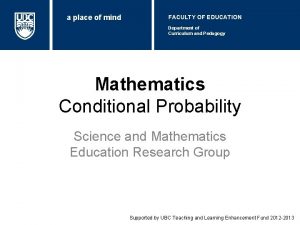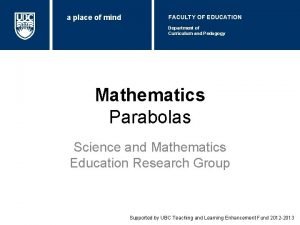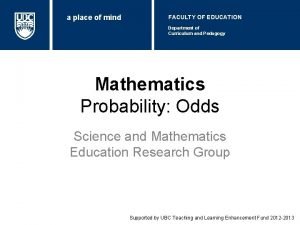a place of mind FACULTY OF EDUCATION Department
















- Slides: 16

a place of mind FACULTY OF EDUCATION Department of Curriculum and Pedagogy Physics Optics: Lenses Science and Mathematics Education Research Group Supported by UBC Teaching and Learning Enhancement Fund 2012 -2013

Lenses f f

Convex Lens I What wave phenomena is mainly involved when using lenses? A. Reflection B. Refraction C. Diffraction D. Interference E. Doppler Shift f

Solution Answer: B Justification: When light is incident on the lens at an angle, this will bend the light due to refraction. This is because the refractive index of glass is larger than the refractive index of air. This means that the light will slow down in the lens. This bending of the light is what results in converging or diverging rays that produce images. Answers A, C, D, and E are the f names of other wave phenomenon.

Lenses II Which set of ray diagrams is drawn correctly? C A f f f B f E. None of the Above f D f f f

Solution Answer: C Justification: A ray passing through the center of a convex lens will not be refracted and will pass through without refracting. The top ray passes through the focal length of the lens, and thus will emerge parallel to the principle ray. f f

Solution Answer A is incorrect because only rays that are parallel to the principle axis when incident on the convex lens will pass through the focus. Answer B is incorrect because parallel rays do not necessarily remain parallel after refraction in a convex lens if they are not incident on the same point. Only the top ray is correct because it initially passes through the focus and so the resulting ray will be parallel to the principle axis. Answer D is incorrect because parallel rays do not necessarily remain parallel after refraction in a convex lens if they are not incident on the same point. Only the bottom ray is correct because it should not refract when it passes directly through the middle of the lens. Answer E is incorrect because it is possible to combine concepts of ray diagrams to select a correct solution out of the options.

Lenses III An object is located a distance two times the focal length (2 f) from a converging lens. Where will the image appear? A B f ½f C D f 2 f E. None of the Above

Solution Answer: D Justification: For a thin converging lens, an object placed at two times the focal length will produce a real image (to the right of the lens in this case). The image will be produced at 2 f. The image will be equal in size, real, and inverted. 2 f f f

Solution Answer A is incorrect because an image will only form in front of the lens when the object is inside the focal length of the lens. Answer B and C are incorrect because, while the image will be formed at a multiple of f to the right of the lens, a ray diagram will show that it does not form at 1/2 f or f. Answer E is incorrect because a ray diagram will show that the image will form at 2 f as a real image. Another option is that the image form as a virtual image to the left of the lens, but this only occurs if the object is inside the focal length of the lens.

Lenses IV An object is located a distance two times the focal length (2 f) from a converging lens. What will the image look like? A. Upright, larger B. Upright, same size C. Inverted, larger D. Inverted, same size f E. Inverted, smaller

Solution Answer: D Justification: When at object is placed at a distance farther than f, the image will be real and inverted. When it is placed at exactly 2 f, the image will be the same size as the object. 2 f f f

Solution Answer A is incorrect because convex lens can only produce an upright, larger image (a virtual image) when the object is inside f. Answer B is incorrect because while an object at 2 f will form an image that is the same size, the image will not be upright. Answer C is incorrect because while the image is inverted, it will only be larger when the object is between f and 2 f. Answer E is incorrect because while the image is inverted, it will only be smaller when the object is beyond 2 f.

Lenses V A candle is placed two focal lengths in front of a converging lens and the image is projected on a screen. If a piece of paper is used to block the top half of the converging lens: A. The entire image disappears B. The entire image remains but is dimmer f C. The top half of the image disappears D. The bottom half of the image disappears E. The image does not change

Solution Answer: B Justification: Blocking the lens does not affect the fact that all rays starting from the same point (i. e. the tip of the candle) will pass through the same image point after going through the lens. The affect of blocking the lens is to half the number of light rays which produce the image, thus making the image dimmer. screen

Solution Answer A is incorrect because there does not need to be a complete lens to form an image. Answer C is incorrect because the paper does not block all of the rays that come from the top half of the candle. Answer D is incorrect because the rays forming the bottom half of the image (closer to the principle axis) are not all blocked. Answer E is incorrect because brightness is determined by the number of light rays hitting the screen at a given point, and the number of rays is halved by blocking half of the lens.
 Mind faculty
Mind faculty Nit calicut chemistry department
Nit calicut chemistry department Importance of faculty in higher education
Importance of faculty in higher education York concurrent education acceptance rate
York concurrent education acceptance rate Faculty of education
Faculty of education Chronicle of higher education faculty salaries
Chronicle of higher education faculty salaries Faculty of education khon kaen university
Faculty of education khon kaen university Mindmaster software
Mindmaster software A wandering mind is an unhappy mind
A wandering mind is an unhappy mind The critical mind is a questioning mind
The critical mind is a questioning mind The characters struggle takes place in his/her own mind
The characters struggle takes place in his/her own mind Millions billions trillions chart
Millions billions trillions chart What is a disturbance that transfers energy
What is a disturbance that transfers energy Disturbance that transfers energy from place to place
Disturbance that transfers energy from place to place 3 uncles of rizal
3 uncles of rizal Tiffany taylor georgia department of education
Tiffany taylor georgia department of education Ryan roemerman
Ryan roemerman






























